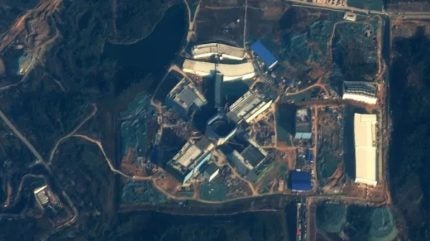
Recent satellite imagery shows a huge centre for laser nuclear fusion in the Mianyana mountains, in southwestern China. The technology involved is inertial confinement fusion (INF) rather than the magnetic confinement fusion being developed at the world’s tokamak facilities. Currently the National Ignition Facility (NIF) at the US Lawrence Livermore National Laboratory if world leader in INF.
The satellite image is attributed to Planet Labs, a California-based integrated aerospace and data analytics company that operates a fleet of more than 200 Earth-imaging satellites. The images were first published by Reuters and CNN.
INF involves creating very high temperature and pressure using powerful lasers placed around the fuel target. Lasers bombard the target forming a plasma, fusing light atoms into heavier ones to produce energy.
The Mianyang centre is significantly bigger than NIF, with an experimental bay 50% larger. The four laser arms converging toward a central chamber is similar to NIF, but much more ambitious. It represents an opportunity to advance in two key areas: energy and military.
While INF technology is seen as a solution for clean and unlimited energy, it also interests the military as it allows for simulating the extreme conditions of a nuclear explosion while complying with international treaties.
Decker Eveleth, an analyst at US-based CNA Corporation has been watching this facility for years. According to CNN, in 2020, a US official released images purporting to show various potential Chinese nuclear locations, including the Mianyang site. However, at this point, it was basically “a patch of dirt,” Eveleth said. After Covid shutdowns were lifted, construction accelerated.
The project is described as a “laser fusion” facility in contract documents obtained by Eveleth and seen by CNN. Eveleth says the four giant arms shown in the satellite image are “bays” which will be able to shoot lasers at the tall, central tower, which houses a target chamber containing hydrogen isotopes.
NIF achieved a world first fusion energy breakthrough in 2022 with a successful nuclear fusion reaction with a net energy gain (although this did not take account of the energy needed to power the lasers). However, the Mianyang facility could now potentially put China in the lead. Melanie Windridge, CEO of industry monitoring organisation Fusion Energy Insights noted: “It signals that they are serious about fusion. They are being decisive, moving quickly and getting things done.”
Brian Appelbe, a research fellow from the Centre for Inertial Fusion Studies at Imperial College London, told CNN that the size of the facility could have advantages. A larger laser allows higher pressures and compression of more material, potentially increasing the energy released. However, he noted that achieving a successful fusion experiment is “extremely challenging” even with a very large laser.
Andrew Holland, CEO of the Fusion Industry Association noted that the US is still ahead in the fusion race for now but “China is moving fast” and has shown it can move from concept to completion much faster than any government programmes. “It is time to build, it is time to invest,” he added. “If the US and its allies do not, then China will win this race.”






